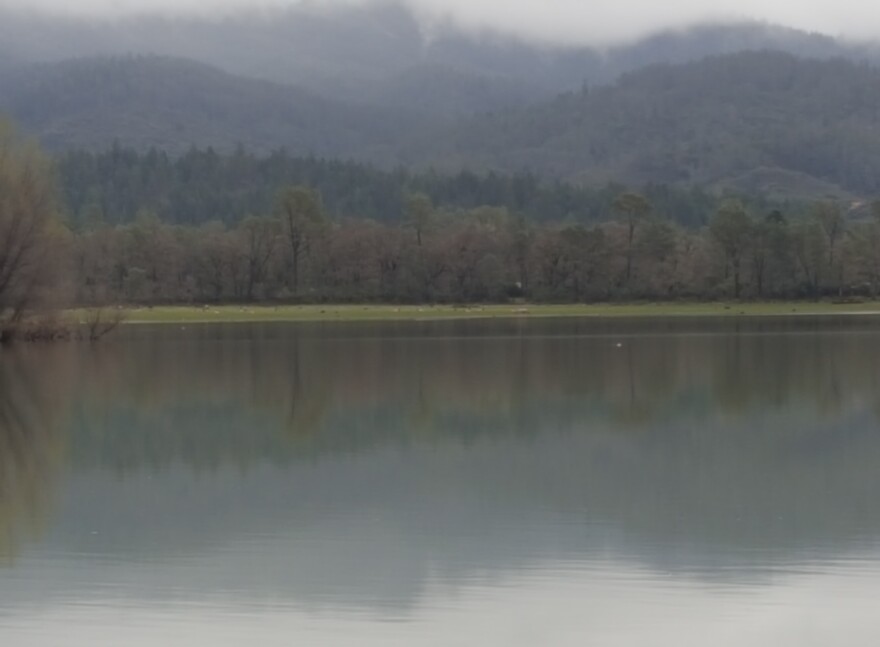May 15, 2020 — The regional coalition that’s working to take over the license for the Potter Valley Project just proposed a plan to remove Scott Dam and Lake Pillsbury and modify the infrastructure at Cape Horn Dam and Van Arsdale reservoir to improve fish passage.
The feasibility study includes plans for sediment and vegetation management to return the basin of Lake Pillsbury to a riverbed, but a lot of questions remain unanswered, including who’s going to foot a bill of unknown enormity: “One hundred million to four hundred million dollars. That’s a huge spread. That tells you that there’s a lot of things that we simply don’t know,” said Janet Pauli, chair of the Inland Water and Power Commission. That’s a joint powers authority which includes representatives from the County of Mendocino, the City of Ukiah, Redwood Valley Water District, Potter Valley Irrigation District and the Mendocino County Russian River Flood Control and Water Conservation Improvement District. The IWPC is one of the members of the coalition trying to take over the license, which PG&E does not intend to renew. At Thursday night’s meeting of the IWPC, Pauli told her fellow commissioners why she thinks it was so important to file the feasibility study report for the proposal this week, one day ahead of the deadline.
“Not meeting this deadline means that we would move into a decommissioning process. And literally we cannot let that happen,” she declared. “It would mean that we would have no control over the project moving forward. We would be outside looking in.”
California Trout, a conservation group that’s part of the same relicensing coalition as the IWPC, has had Scott Dam in its sights for a while now. Last year, it included the 100-year-old dam in its report calling for the removal of five dams in California which, in its estimation, no longer serve their original purpose; block access to habitat; and are vulnerable to removal efforts.
Darren Mireau is the north coast director for CalTrout, in Arcata. He also thinks the stakes are pretty high.
“We have several different studies indicating that there’s substantial habitat available for anadromous salmon and steelhead above Lake Pillsbury and Scott Dam, for both Chinook salmon and steelhead. And both of those species are listed as threatened on the Endangered Species Act,” he said. “So we want fish to get up there.” He added that the habitat, which is protected public land in the Mendocino National Forest and has a wide range of temperatures and conditions, is ideal, both for fish in their various life stages and for establishing resilience to climate change.
Friends of the Eel River is another conservation group that’s not part of the relicensing coalition. But it is part of the two-basin ad hoc committee convened by Congressman Jared Huffman to satisfy the environmental and water supply priorities of the Eel and Russian River watersheds. Friends of the Eel has always advocated for decommissioning the entire project. But as it stands right now, Conservation Director Scott Greacon is leery of the decommissioning process.
“Really, the big question that (the) filing is an answer to is, is there anyone who wants to and has the capacity to take over Scott Dam from PG&E?” he reflected. “And the answer is no.” Like Pauli, he believes that if the relicensing process were not underway, the Federal Energy Regulatory Commission would order PG&E to decommission the entire project — and would then allow the company to pass the costs along to its ratepayers. “If that were the process, then we’d know that PG&E would pay and would get their work done,” he said. “The plan we have right now looks both more expensive and less certain. So I think that causes us a lot of worries.”
Pauli also wants PG&E to pay something. And she expects water users to pick up the operation and management costs of the project in its final form, if a regional entity takes ownership. She believes there are potential funding sources for the capital costs, but, “It’s a really good idea, before you go asking for money, to know how much you’re going to ask for. So we’re a little bit far away from that, I’d say, at this point.” She assumes PG&E will spend some money, but the amount is unknown at this point. “There’s some ideas. None of it gelled yet,” she cautioned her fellow commissioners. The important thing for Russian River water consumers to remember, she said, is, “Once whatever project is put into place, whatever it ends up looking like, the people who benefit from the water are going to be responsible for picking up the O&M (operation and management) costs. And we believe those are anywhere from five to ten million dollars per year.”
For Friends of the Eel, the plan is partway to its goal of removing the project. And for the IWPC, it could be a stopgap. “It is not a commitment,” Pauli specified. “It will not become a commitment until the final license application has been submitted to FERC and has been accepted.”



